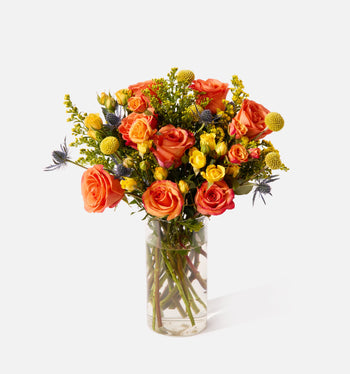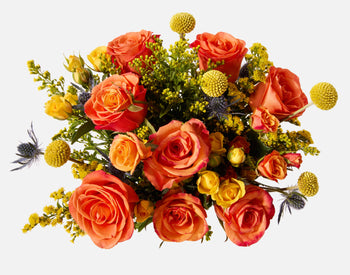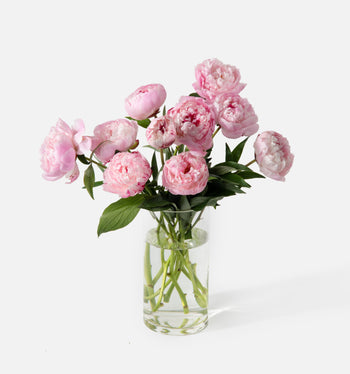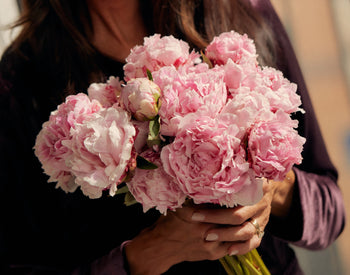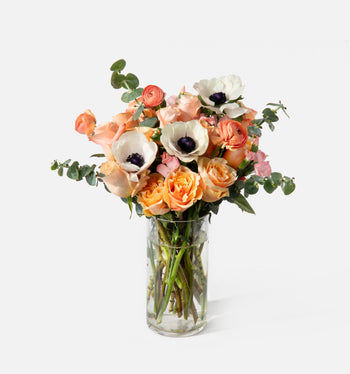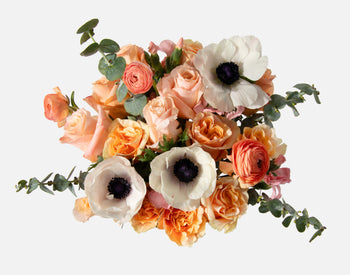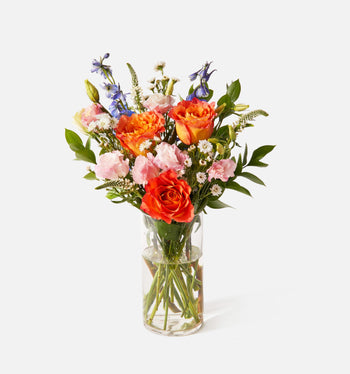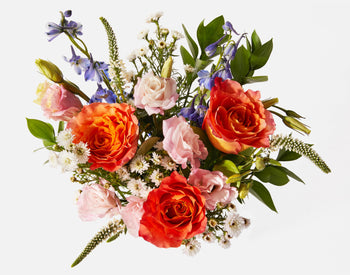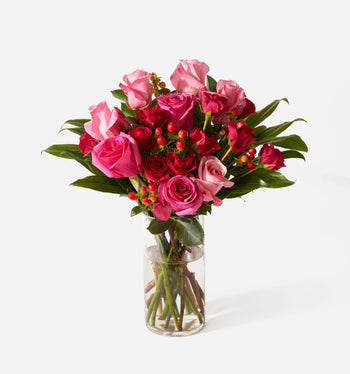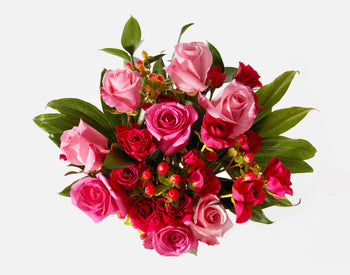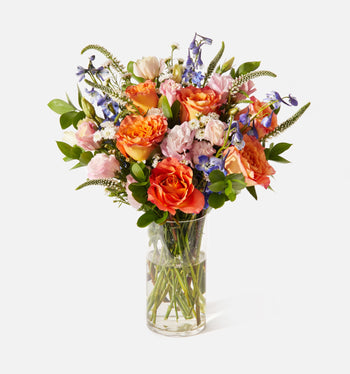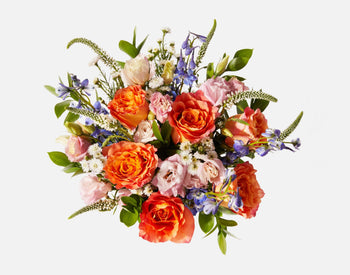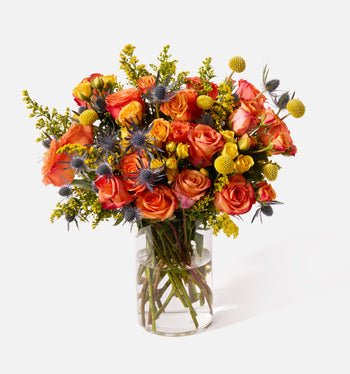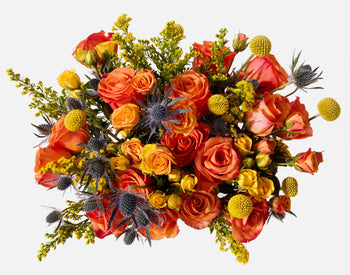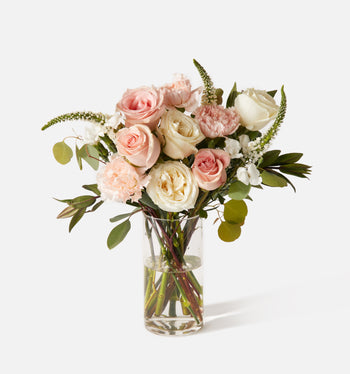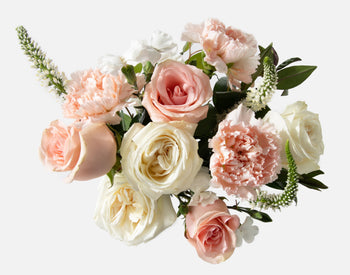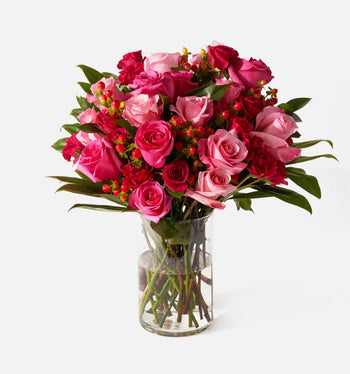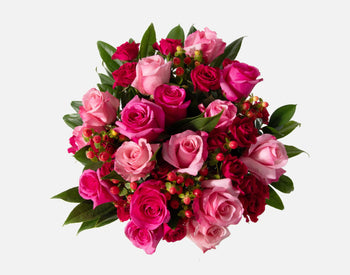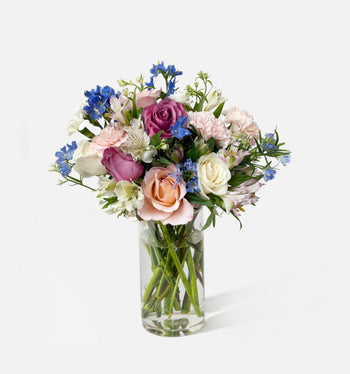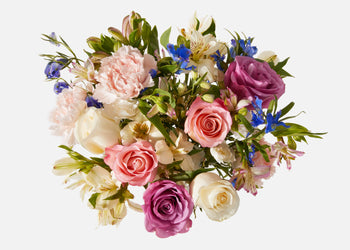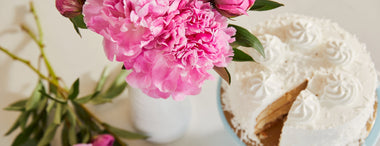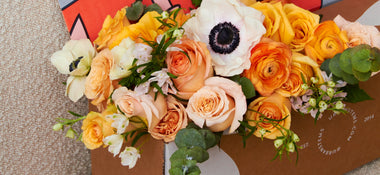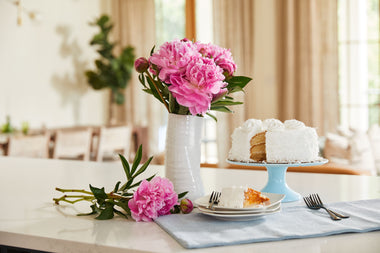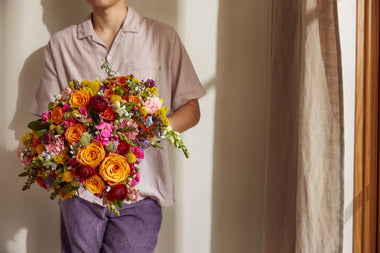Roses love the summer heat, and as the weather warms they spill their glorious color and fragrance across the season. If you’re sending roses, now is a great time to look for specialty roses (like the “Free Spirit” garden roses in our Good Vibes bouquet), and the same advice applies for gardeners! Knockout roses are definitely the easiest roses to grow, but less beautiful and far less rewarding than specialty English roses, or climbing roses. Imagine an arbor draped in sweet roses! Why deny yourself that?

You won’t find these in an UrbanStems bouquet yet, but these viney babes are the bees knees (Literally! Bees and other pollinators like them!). They grow in a variety of shades of purple and white, and add a whimsical touch of color and movement to any garden space! Pro-tip: clematis plants prefer to be planted in a place where the vines get full sun but the roots are shaded and kept cool. You can achieve this with strategic planting and by making sure to mulch around their roots.
On the subject of vines, honeysuckle is an amazing plant. They smell sweet, attract hummingbirds, and grow in long tendrils (have you gathered that I have a thing for vines yet?). They’re also semi-evergreen in most parts of the country so they’ll keep their foliage and size even when their bloom is finished.
You’ll absolutely find sunflowers in our assortment, in beauties like The Neon Lights and The Tuscany, but they’re a wonderful plant in the garden as well! They can grow to incredible heights and, if you want to be a very chic foodie type, you can let the sunflower heads fully mature (and fight back the critters who will go after the seeds) and then grill your sunflower heads! Personally, I think the best gardening is delicious gardening.

These are some of the most incredible flowers I’ve ever grown. They produce bright clusters of flowers (available in shades of pink, red, orange, yellow and white) and will bloom continuously during the summer months if you dead-head them. They make amazing container plants for borders in a garden and, get this, they’re drought resistant! Once they’re naturalized, they thrive in dry hot conditions, which you’ll be grateful for when you don’t want to water in the August heat.
Look, I used to think that geraniums were just for older ladies’ porch planters as well, but they’re not! And two things turned me around on the matter: 1. geranium oil in skincare serums and other products is fabulous and 2. hardy (or native) geraniums are a beautiful and low-lying addition to any garden.
Also called “Tickseed” but we’re not doing that. That sounds unappealing. Anyway, coreopsis are fantastic plants and their flowers are like literal sunshine on stems. Who could be mad at that? They do all right in containers, but I think they really shine when planted in the garden to add color and attract happy little pollinators.
Speaking of pollinators, milkweed! Butterfly Bush can be great for its color, but it’s invasive in most of the United States and though its flowers attract butterflies, its foliage and branches can’t sustain caterpillars. So, what do we do instead? We plant native plants to support pollinators. In this case, milkweed supports a number of butterflies, but most famously The Monarch Butterfly on its long journey from Central America to the United States during their migration. Milkweed is typically orange, but these days you can find yellow, pink, and even white varieties to suit your tastes!
Not every flowering plant wants to spend all its time sunbathing, which brings us to the humble Begonia. Most flowers can’t take credit for thriving in the shade while leaving the spotlight to others, but the begonia can. She comes in shades of pink, white, red, orange, and yellow and can thrive in containers or in the ground as long as she’s getting part shade. Perfect for those spots where you can never seem to get enough sun.
I am cheating here because Caladia aren’t flowering plants but my blog post, my rules. Caladia are gorgeous leafy plants that add broad leaves in shades of green, white, and pink to any planting. I’ve had particular success using these in planters on a shady porch or patio, but again they’re a wonderful addition to a dim spot in the garden.
In bouquets like The Bestie and The Proud are annuals at least where I live (in the New York City area), but they’re wonderful plants to add height and drama to your garden. Their flowers grow in long spires and are sure to attract the attention of passersby. Likewise, when they’re in a bouquet of cut flowers they add a moment and drama that wouldn’t be there without their cute blooms.

Like snapdragons, Delphinium will add height and movement to any arrangement with their elegant stems. They come in whites, pinks, and purples, but Delphinium are definitely best known for their striking blue color. As it happens they’re some of the only true blue flowers. I personally love them in bouquets like The Nantucket where their saturated stems play among crisp whites and greens. It reminds me of froth on the sea.

To be fair, this isn’t a single type of flower, but the category deserves its own attention. Maybe you’re lucky enough to live somewhere tropical and you’re able to grow birds of paradise, curcuma, or ginger, but not all of us have that kind of luck. Some of us live in New York and can only enjoy interesting tropical flowers in bouquets like The Queen Protea.
Some varieties are also called Rose of Sharon; not personally sure who Sharon is, but she has great taste. Hibiscus, for most folks in the U.S., will be an annual, meaning that it will only survive a season and die during the winter. However, if you want flowers on flowers on flowers, hibiscus is the girl for you. Whether you grow them as a shrub or trimmed into a standard (meaning a lollipop shape), these plants are so productive that you won’t know what to do with yourself.
AKA Echinacea - coneflowers are sweet daisy shaped flowers that come in a wide array of colors and styles. They’re a relatively low maintenance way to add interest to your garden, and pollinators adore them!
This doesn’t count as cheating, because these plants do have delicate little flowers (in fact, the most famous variety is called “Coral Bells” for its delicate coral colored blooms), but most folks cultivate heuchera because of its colorful foliage. As the summer wanes on, and your blooming plants begin to die back, it’s important to keep beautiful color in the garden and foliage plants like Heuchera are a great way to achieve that end!
We’re back to vines again, sorry! But we have to be because Akebia is a wonderful trailing plant that enjoys part to full sun and (this is the important part) when the flowers bloom in early Summer they smell like chocolate!
This is the New England-er in me and I know that. But I cannot deny the glory of an abundant hydrangea bush during the summer. Coming from the industry, IU do need to say that I admire you, reader, and your efforts to change the color of your hydrangea blooms with eggshells in the soil, or special fertilizer, or whatever your special trick is. However, I do think your energy might be better spend just appreciating the Hydrangea as they are. If you’re a lover of hydrangea, you have my heart and I’m hoping to work them into our UrbanStems designs very soon!
These flowers (available in bouquets like The Summer Love) get a bad reputation for being “cheap” but they’re available in literally every color, they add a ton of volume to a bouquet once they bloom, and they last a very long time! My mom used to keep a vase of these (we called them “Peruvian Lilies” then) on our counter and they always lasted more than a week!
Aren’t orchids always in style? Like, look at The Coastline and tell me she isn’t chic. It simply isn’t possible. Now, these are a bit different from their sisters on this list – orchids wouldn’t go in the garden outside. But as someone who lives in an apartment, I say all plant parenting counts as gardening! Anyway, if you want to give someone the gift of an orchid, the warmer summer months are a perfect time to do just that! When temperatures fall below 45 degrees Fahrenheit, orchids start to suffer and their un-bloomed buds will die off very quickly. Summer, on the other hand, is as luxurious for orchids as it is for us.
Back to more traditional gardening, I can’t write a list of great summer flowers that excludes balloon flowers. They come in white and purple and grow little balloon shaped flowers (hence the name) that eventually burst open at the end. If you catch them at the right moment, and squeeze an unopened flower between your fingers, it will actually “pop” open!
Otherwise known as Rudbeckia, are wonderful perennial flowers that basically look like miniature sunflowers. However, Black-Eyed Susans grow much shorter and flower way more abundantly. Who couldn't use a little more sunshine in their gardens and their lives?
These cuties look like a cross between miniature roses and succulents! They grow low to the ground and love direct sun, and they grow brightly colored little florets that look like roses! If you’re looking for these at the garden center, you might need to call them “Portulaca”.
Day-Lilies are glorious when used well. They’re not “true lilies” if you want to dig into the botany, but I don’t so we’re forging ahead. Day-Lilies grow bright, lily shaped flowers on tall stems over grassy foliage. They grow in clusters and can create a very lush display when planted together. They also self-divide, meaning that if you leave them alone, they’ll multiply and you’ll have more flowers each year!
Feeling inspired to surround yourself with some summer blooms? You can shop our entire Summer Collection and brighten up any space.


